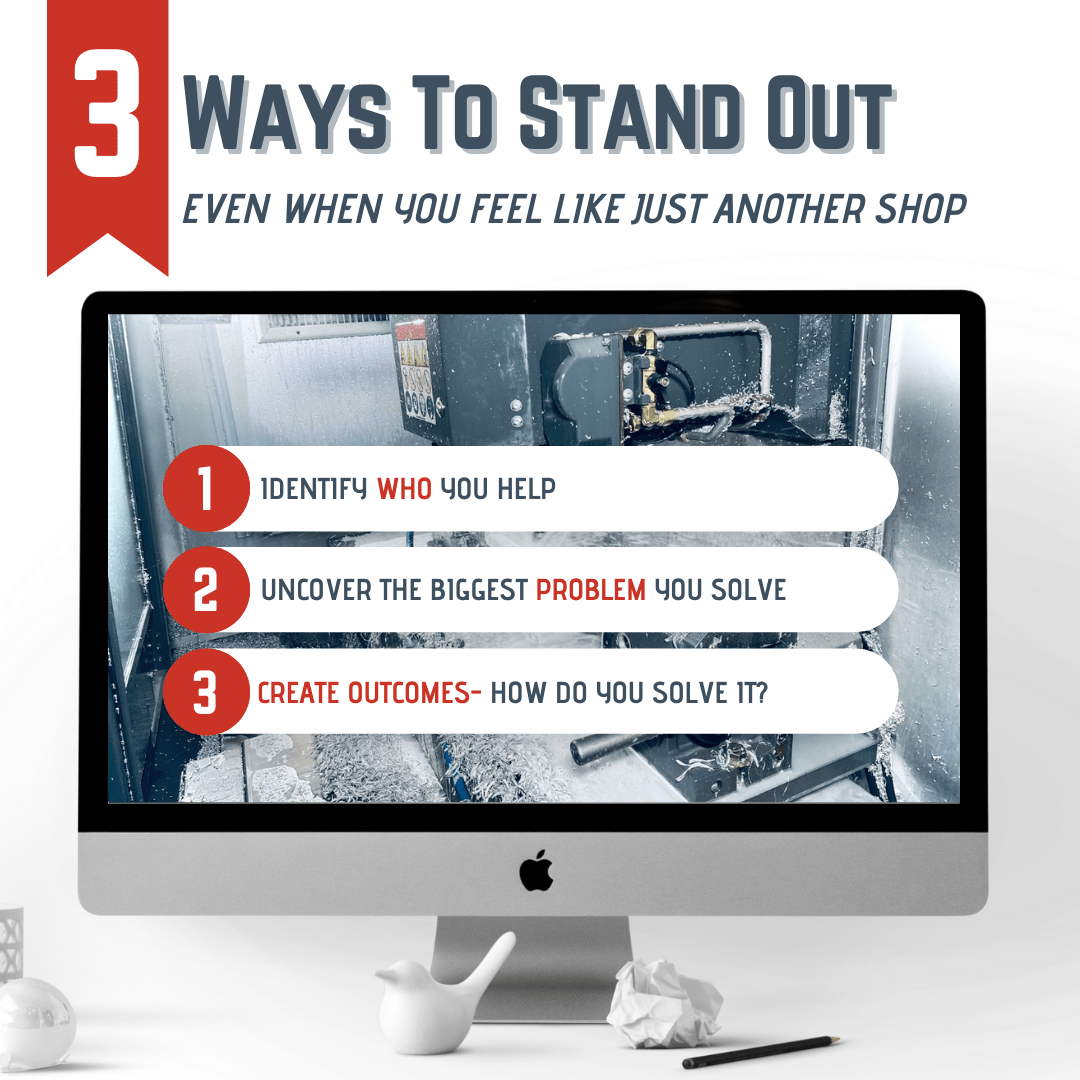Part 1 of 4
What Problem Do You Solve for Your Customers?
Let’s face it: in manufacturing, we struggle to set ourselves apart from our competitors. You partially believe that your shop isn’t actually very different from others like yours, and that’s part of the problem.
We felt that way a few years back when we were referred to Donald Miller’s book, Building a StoryBrand, and everything changed.
We learned that while a typical brochure in manufacturing was all about our own company, that wasn’t the right approach. Nobody wants to hear about what we do until they understand how we can help them; specifically, how we can solve a problem in their world.
We began our journey to overhaul the way we spoke about ourselves and reached out to the marketplace.
We’ve made a few mistakes along the way, and this blog is the start of a series describing the challenges we overcame so that you can figure it out more quickly than we did.

1. Identify Who You Help
In the Building a StoryBrand framework, the Customer is the Hero of the story. This was a major shift in how we thought about getting our company message out there—but in hindsight, it makes complete sense. Knowing how you can help a Prospective Customer is the most important part of the story.
Identifying that Customer isn’t always easy, however. The good news is, you’ve already got Customers, so you just need to identify their common traits.
Too often when you think of your Customers, you start listing company names. While it’s true those are your Customers, you actually need to start thinking about the people that are making the decisions to purchase your products or services. People buy stuff for Companies, and it’s the people we need to reach.
Nowadays in marketing articles, it’s fairly common to hear about “Buyer Personas”. This is a helpful way to think about your ‘typical’ Customer: describe him (or her) in significant detail so you’ll have a sense of what matters to them. It also helps to have an individual in mind when you’re writing the copy in any email or on your website.
The more clearly you can describe who your customer is (and who they are not), the better off you’ll be.
Ultimately, to stand out from the competition, you’ll want the right Prospects to read your messaging and say to themselves, “That’s me!”, at the same time everyone else reads it and says “That’s not me!”.
You only want the right people to respond—not everyone.
If everyone responds—even the ones that aren’t really good prospects for you—you can easily get buried in inquiries that will just end up wasting your time. We have all experienced this.
Many companies write their messaging in very general terms so no potential prospects will feel left out. It’s counter-intuitive, but while that language won’t exclude anyone, it’s so vague that hardly anyone would read it and say, “That’s me!”
You want your Prospect to read your message and easily be able to self-identify the message was meant for them.
Finally, you want to consider who you’d actually want to be your Customers. Deciding to target particular aspects of the market based on the kinds of people you prefer to deal with is an opportunity to subtly shape your business into the future.
Here’s an example of what we uncovered for ourselves in identifying our Customers:
- We narrowed the types of Companies that could be where prospective customers might be:
- Aerospace & Defense – Our AS9100 certification has value to those entities
- Larger manufacturers – Dealing with large defense contractors isn’t easy and we’ve got the experience to handle their system requirements
- Start-Up or Growing manufacturers – New projects needing development require an openness to delayed gratification that we believe is worth the effort
- Then we identified the main category of people we were looking for:
- Manufacturing professionals – In larger companies, they come with a variety of backgrounds
- Manufacturing owner/operators – Start-up or growing manufacturers have leaders calling the shots and looking for solutions
- We also listed some of the characteristics of the people that we knew were a fit
- Ownership mindset
- Thoughtful & detail-oriented
- Collaborative
- Finally, since we also have a bunch of young, recently graduated engineers that are learning both manufacturing and business, we identified two main personas from the above criteria for our use:
- Manufacturing professional or owner/operator – Long-time in manufacturing and business (typically either owns the company, runs a division, or handles the Purchasing operation of a larger entity)
- Young, recently graduated manufacturing professional – Early career and learning what manufacturing is all about
- Company category (size, products, industry, geography, etc.)
- People’s characteristics (role, attitude, competencies, etc.)
2. Uncover the Biggest Problem You Solve for Them
In the StoryBrand framework, once you’ve identified the Hero of the story (your Customer), you need to identify their Biggest Problem. There are 3 levels of problem that you can identify to help form the message you’ll share with them:
Level 1 – External Problem – What is the problem your customers deal with in regards to your product or service?
Identifying the External Problem you solve for your Customers might seem obvious at first glance. Your product or service allows them to sell to their Customer. Start with the biggest struggle people in your industry complain about: is it Lead Time, Inventory Management, Communications, or something else?
You partly want to see what the problems might be, as well as determining a big one you’re uniquely positioned to solve for your Customers.
If you identify a problem your company isn’t good at solving, it’s not going to be helpful to you.
Above all, describe the problem clearly so someone will raise their hand to say “Yep, that’s me!”. And if you’ve communicated well, the folks that don’t have the problem will just as quickly say, “Nope, that’s not me!”.
Here’s an example of how we identified the External Problem for our Customers:
For us, our Customers are looking for CNC Machined components & assemblies. They need them when they need them (On Time Delivery), made to specifications (High Quality), and at a price that they can charge the end customer (Competitive).
Initially, we used that list as our answer and continued along in the framework. In hindsight, we needed a better way to more succinctly describe what they were feeling.
Summarizing the problem our Customers have is that they want the control and benefits of an In-House Shop for their CNC Machined parts, despite not having the internal capacity.
They’d much prefer not to have to manage input from other companies but are forced to go outside their four walls to get the components they need.
Level 2 – Internal Problem – How is this problem making them feel?
The Internal Problem is all about the emotional challenge of our Hero. Many Customers face frustration or worry. In this case, it’s all about their emotions. This is where the people aspect of the conversation comes in.
General examples of Internal Problems include:
- Frustration from lack of good information
- Fear of their boss if things go wrong
- Worry that they missed an important detail
- Overwhelm at the amount of work they need to do each day
- Boredom from their tedious work
Your ability to describe how they’re feeling is key to having them emotionally connect with your message.
Here’s an example of how we identified the Internal Problem for our Customers:
For us, our Customers are feeling Frustrated by their Supply Chain and wish they had an in-house shop instead of outside vendors. Their frustration is compounded when conditions change and they struggle to get clear answers (or any answers!) from suppliers on the status of projects or anticipated delivery dates. Lacking information is typically the biggest frustration of all!
Level 3 – Philosophical Problem – Why is it “just plain wrong” for your Customers to be burdened with this problem?
You can think of the Philosophical Problem your Customer faces as the injustice you and your company are out to overcome through the activities of your business. What’s the wrong you can make right by your products or special brand of service? It could be as simple as, “It’s just plain wrong that someone can’t find aluminum stock on the shelf in Cleveland, Ohio!”.
These don’t have to be society-altering injustices (although the more compelling the problem, the quicker the prospective Customer will be drawn in).
Your ability to identify the Philosophical Problem you solve can both help your Team feel like they’re on a quest to right a wrong and can have your Customer want to engage because they want to break free of that exact problem.
Here’s an example of how we identified the Philosophical Problem for our Customers:
For us, we believe it’s just plain wrong that Manufacturing Customers can’t have vendors who make them feel like they’re just an extension of their own companies! We engage deeply with our Customers and fully understand the challenges they’re facing in the projects we’re partnering on. Customers shouldn’t have to be asking for status updates, even in times of crisis….especially in times of crisis. Not getting contacted if a delivery date is delayed is unacceptable. Manufacturing has lots of variables and despite Murphy living everywhere, it doesn’t have to be made worse by not providing timely updates—especially if something goes wrong.
We believe vendors are critical partners in Manufacturing and need to step up with service levels that would be expected from an in-house shop.

3. Consider Outcomes – How Do You Solve Their Problem?
Obviously, looking exhaustively at all aspects of the problems your Prospects are facing can help you stand out from your competitors. Merely identifying the problem and putting it into words will draw people with that problem to you.
Before you start drawing people in, however, you want to develop a clear idea of how you’re going to solve that problem for them. That’s an important check to make sure you’ve identified the problem that makes the most sense for you.
Simply creating clarity around the problem will help rally and focus your Team on delivering the correct solutions to your Customers.
Here’s an example of how we identified the Solutions We Use to Solve the Problem for our Customers:
For us, there are three main ways we’ve developed to ensure we feel like an extension of our Customer’s company:
- We provide Weekly Status Updates to every customer listing every open PO line with the updated status of the part. Any notes that changed from last week’s report are highlighted for the ease of spotting the new information.
- We provide Shipping Updates to every customer the morning after any shipment to provide them with the Product, PO, Quantity, Expected Delivery & Tracking Information. This allows the company to anticipate the arrival of the product and know when it’s en route.
- We assign a pair of our Teammates to be Customer Champions for each of our Customers inside our building. These Customer Champions are involved in providing the Weekly Status Updates, advocating within our Team on their projects, and helping provide context to our Company on the particular needs of that Customer.
We believe that engaging our Teammates with the people inside our Customers, provides extra motivation for our Team to deliver results and transparency as if we were an In-House Shop for our Customers.
With a clear problem statement in place, special emphasis should regularly be placed on brainstorming additional ways you and your Team could even more completely solve your Customer’s problems.
In the next blog in the series, we’ll share how you can establish yourself and your Team as the Guide for your Customers, and share with them a simple plan to help them overcome the clear problem you’ve clarified for them.
Take this time to complete the Action Steps, and you’ll be ready for the next stage of the process.





